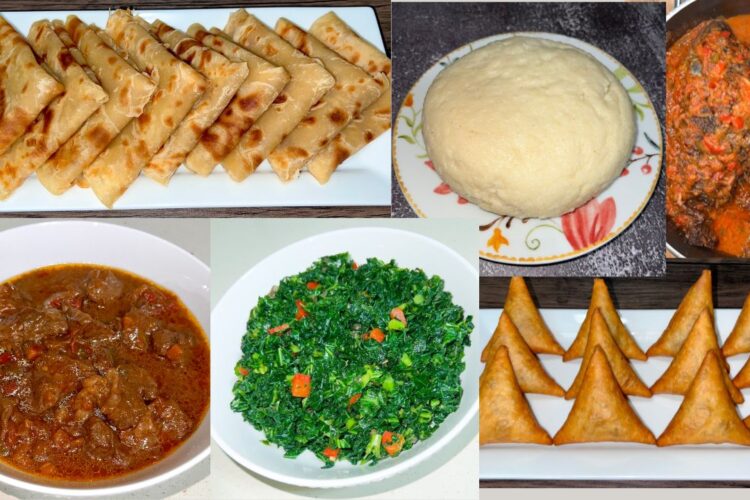This post may contain affiliate links, which means I may receive a commission from purchases made through the links.
What is East Africa Known For?
East Africa is a region renowned for quite a number of things (not bragging at all), including its crazy fast marathoners, breathtaking landscapes, thriving wildlife, and captivating cultures like that of the Maasai. Hey, the region offers some of the top safari destinations in the world! But what is not talked about a lot, regarding East Africa, is its flavorful cuisines – how rich and diverse they are. That breaks my heart as a food enthusiast, and I am here to right that wrong. We’re comparing the cuisines of Kenya, Uganda, and Tanzania, where every dish tells a story. If you’ve ever wondered how these countries each put their own spin on the same basic ingredients to create masterpiece dishes, the answer is right here.
Kenya, Uganda, and Tanzania each bring their own delicious flavors to the table, thanks to their rich histories and local ingredients. Even though these three countries are close neighbors and share a lot of culinary vibes, each one has its own unique twist that makes its food special. In this article, we’ll discuss how their cooking traditions compare and contrast to captivate everyone—locals and visitors alike.
The Similarities between the Cuisines of Kenya, Uganda, and Tanzania
Kenya, Uganda, and Tanzania have a lot in common when it comes to food, thanks to their close proximity and shared history. Take Lake Victoria, for instance—it’s a big fish tank that all three countries love to dip into. Tilapia, Nile Perch, and dagaa (omena) are some of the most popularly consumed fish across the region. But that’s not all these countries have in common. There’s more:

Staple Foods: All three countries have some form of maize, millet, and cassava on their menus. Ugali is the star player here, showing up at almost every meal, often paired with tasty stews and leafy greens.
Grilled Meat: Known as Nyama Choma in Kenya and Tanzania, and simply ‘Roast Meat’ in Uganda, this is the ultimate BBQ. The meat is often marinated, grilled to perfection, and usually served with veggies, salads like kachumbari, and some kind of starch.
Vegetable Stews: Each country loves its vegetable stews, which are commonly cooked with tomatoes, onions, and spices. You’ll find hearty stews with kale, cabbage, spinach (or Swiss Chard), and other local greens. These veggies often team up with ugali but can also hang out with rice dishes or chapati.

Snacks and Street Food: Fried goodies like samosas, maandazi, and bhajia are everywhere. They’re perfect as snacks, breakfast, or street food. Roasted maize is also a popular treat you’ll find at street stalls throughout the region.

Basically, Kenya, Uganda, and Tanzania have a lot in common when it comes to food. My brief list is by no means exhaustive of all the shared similarities across the three countries. Rather, it is meant to give just a glimpse as we dive more in-depth into the uniqueness of each of these countries’ cuisines.
My Amazon Affiliate Links
- Non-stick crepe pan (Commissions Earned): https://amzn.to/4fDSPbQ
- Non-stick frying pan (Commissions Earned): https://amzn.to/3XacJEl
- Euchoiz Silicon pastry mat (Commissions Earned): https://amzn.to/4fEIJHK
- Rolling pin (Commissions Earned): https://amzn.to/4clguej
- Pastry scraper (Commissions Earned): https://amzn.to/4cuG1lu
- KitchenAid Measuring cups (Commissions Earned): https://amzn.to/3MmlepD
- Pyrex measuring cups (Commissions Earned): https://amzn.to/4dEMriJ
- Mixing bowls set (plastic) (Commissions Earned): https://amzn.to/3YA1O7U
- Mixing bowls (glass) (Commissions Earned): https://amzn.to/3WFSFb9
- Stainless whisk (Commissions Earned): https://amzn.to/3M1sdUz
- Kitchen towels (flowery patterns) (Commissions Earned): https://amzn.to/3AlgEVK
- Kitchen towels (plain colors) (Commissions Earned): https://amzn.to/3M2Dfcg
- Pastry/basting brushes (Commissions Earned): https://amzn.to/3X0kAUE
The Differences between the Cuisines of Kenya, Uganda, and Tanzania
Kenyan Cuisine
First up, let’s talk Kenya. Kenyan food is like a party on a plate, full of bold flavors and comforting bites. Picture this: a steaming mound of ugali, the maize-based staple that’s as essential to Kenyans as a good pair of sneakers is to a workout lover. It’s the ultimate sidekick to the juicy nyama choma (grilled meat) that’s often served with a zesty kachumbari salad (a salad made of tomatoes and onions, for those not in the know). And let’s not forget about sukumawiki, a simple yet scrumptious sautéed kale dish that proves you don’t need a lot of fuss to make something fabulous. Just so you know, I’ve got recipes for some of these delicacies right here on this blog, so if you wish to check them out and try them before you even set foot in Kenya, all you gotta do is click on those links.
Kenyan food mixes up influences from Indian, Arab, and local African traditions. Therefore, in addition to the traditional staples listed earlier, dishes like chapati (flatbread), pilau, and biriani hint at Indian and Arab influences. And let’s not forget the street food scene, where samosas, maandazi, and bhajia also exemplify the shared history with India and the Middle East while others like roast maize and mutura (a Kenyan grilled sausage) showcase the country’s traditional creations. You can learn more about these and other popular Kenyan dishes from this article I wrote on 15 must-try Kenyan dishes for any visitor, where I also describe each dish in more detail.

Ugandan Cuisine
Now, let’s hop over to Uganda, where the food is all about heartiness and homey goodness. Ugandan meals are like a warm hug from your grandma. Their staple, posho, is a maize flour dish similar to Kenya’s ugali but with a finer texture. It’s usually paired with rich stews like luwombo, a savory mix of meat and creamy groundnut (peanut) sauce that’s so delicious it might make you rethink every other stew you’ve ever had.
Another Ugandan favorite is Matoke, a dish that involves steaming green bananas to a tender perfection. This Ugandan classic will make your taste buds do a happy dance, no kidding. Matoke is mostly served with pure groundnut sauce or luwombo, which clarifies one point: that, in Uganda, groundnuts are kind of a big deal. They appear in a ton of recipes. Thanks to its deep agricultural roots, Uganda is known for its plentiful fresh produce ranging from vegetables to fruits, grains, and much more. As such, Ugandan food is all about comfort and heartiness.
On the street food front, Uganda’s got creativity covered with treats like the rolex—a chapati rolled up with eggs and sometimes, veggies. Roasted plantains, cassava, and sweet potatoes, alongside meat on skewers and roasted maize also make for tasty street snacks that showcase Uganda’s knack for turning simple ingredients into delightful bites.
Tanzanian Cuisine
Finally, let’s explore Tanzania, where the cuisine is as lively as a coastal carnival. Tanzanian food, like Kenya’s, gets a big boost from its coastal vibe and historical trade routes. The cuisine here is a spice lover’s dream, bursting with flavors from all kinds of aromatic spices. Ugali is still on the menu, but here it’s often served alongside or substituted with fragrant rice dishes like pilau and biryani. These dishes are a nod to the country’s connections with Indian and Arab traders, and you can taste the influence in the generous use of spices like cloves, cumin, cinnamon, and cardamom among others. I discuss further the shared food culture with India and the Middle East in this article on Swahili food and the influences of Indian and Middle Eastern cuisine.

Zanzibar, the spice island, adds a unique flair with dishes like Zanzibar pizza – a fried dough filled with a variety of savory ingredients. The Tanzanian love for seafood also shines through, especially along the coast like in Dar es Salaam where fresh catches are effortlessly turned into culinary masterpieces. So, if you’re into food that’s rich, fragrant, and full of zest, Tanzanian cuisine will definitely hit the spot!
To summarize the differences, while Ugandan, Kenyan, and Tanzanian cuisines share staples like maize-based dishes and grilled meats, they each have distinct flavors and preparations that reflect their unique cultural and historical influences. Uganda’s cuisine leans towards hearty, peanut-based stews; Kenya’s incorporates Indian spices and diverse dishes like sukumawiki; and Tanzania’s food features coastal influences with dishes like pilau and Zanzibar pizza.
Conclusion on the Cuisines of Kenya, Uganda, and Tanzania
In conclusion, looking into the culinary traditions of Kenya, Uganda, and Tanzania, it is clear how each country’s historical context, geographic location, and cultural interactions have shaped its food. From the Indian Ocean’s influence on Tanzanian spices to the agricultural roots of Ugandan staples and the fusion of international and local flavors in Kenya, the cuisines of East Africa are a testament to the region’s rich and diverse heritage. It is like a flavor adventure waiting to be explored. So, grab your fork, loosen your belt, and get ready to enjoy these East African delicious delights!
My Amazon Affiliate Links
- Non-stick crepe pan (Commissions Earned): https://amzn.to/4fDSPbQ
- Non-stick frying pan (Commissions Earned): https://amzn.to/3XacJEl
- Euchoiz Silicon pastry mat (Commissions Earned): https://amzn.to/4fEIJHK
- Rolling pin (Commissions Earned): https://amzn.to/4clguej
- Pastry scraper (Commissions Earned): https://amzn.to/4cuG1lu
- KitchenAid Measuring cups (Commissions Earned): https://amzn.to/3MmlepD
- Pyrex measuring cups (Commissions Earned): https://amzn.to/4dEMriJ
- Mixing bowls set (plastic) (Commissions Earned): https://amzn.to/3YA1O7U
- Mixing bowls (glass) (Commissions Earned): https://amzn.to/3WFSFb9
- Stainless whisk (Commissions Earned): https://amzn.to/3M1sdUz
- Kitchen towels (flowery patterns) (Commissions Earned): https://amzn.to/3AlgEVK
- Kitchen towels (plain colors) (Commissions Earned): https://amzn.to/3M2Dfcg
- Pastry/basting brushes (Commissions Earned): https://amzn.to/3X0kAUE






